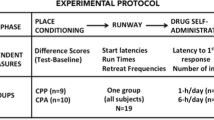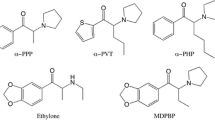Abstract
Daily administration of a drug in a distinctive environment establishes contingencies that support Pavlovian conditioning. Environmental cues that are paired with the drug injection and that predict the onset of drug action can become conditioned stimuli. Ultimately, the conditioned stimuli come to predict the availability of drug and develop the potential to engender conditioned drug responses. Various psychostimulant drugs can produce conditioned locotnotion when tested in the presence of environmental cues that were repeatedly associated with the drug experience. The ability of amphetamine and cocaine to produce conditioned locomotion was demonstrated in the present study. Stimulant-like properties of methylenedioxymethamphetamine (MDMA) have been reported in locomotor paradigms, drug discrimination procedures, and human subjective questionnaires. MDMA (5 mg/kg), paired for 5 days to a distinct environment signalled by the presence of a distinct odor, produced enhanced locomotion during a test probe with the odor alone indicating that MDMA can also produce conditioned locomotion. The observation that the stimulus properties of MDMA can also become associated with environmental cues supports the hypothesis that some of the behavioral effects of MDMA resemble those of other classical psychostimulants such as amphetamine and cocaine.
Similar content being viewed by others
References
Barnes D (1988) New data intensify the agony over Ecstasy. Science 239:864–866
Beardsley P, Balster R, Harris L (1986) Self-administration of methylenedioxymethamphetamine (MDMA) by Rhesus monkeys. Drug Alcohol Depend 18:149–157
Beck J, Morgan P (1986) Designer drug confusion: a focus on MDMA. J Drug Educ 16:287–302
Beninger RJ, Hahn B (1983) Pimozide blocks establishment but not expression of amphetamine-produced environment-specific conditioning. Science 220:1304–1306
Borberg S (1974) Conditioning of amphetamine-induced behavior in the albino rat. Psychopharmacology 34:191–198
Braun U, Shulgin A, Braun G (1980) Centrally active N-substituted analogs of 3,4-methylenedioxyphenylisopropylamine (3,4-methylenedioxyamphetamine). J Pharm Sci 69:192–195
Bridger WH, Schiff SR, Cooper SS, Paredes W, Barr GA (1982) Classical conditioning of cocaine's stimulatory effects. Psychopharmacol Bull 18:210–214
Childress AR, McLellan AT, Ehrman R, O'Brien CP (1988) Classically conditioned responses in opioid and cocaine dependence: a role in relapse. In: Ray BA (ed) Learning factors in substance abuse, NIDA Research Monograph 84, pp 25–43
Gawin FH, Kleber HD (1986) Abstinence symptomatology and psychiatric diagnosis in cocaine abusers. Arch Gen Psychiatry 43:107–113
Glennon RA, Young R (1984) Further investigation of the discriminative stimulus properties of MDA. Pharmacol Biochem Behav 20:501–505
Gold LH, Koob GF (1988) Methysergide potentiates the hyperactivity produced by MDMA in rats. Pharmacol Biochem Behav 29:645–648
Gold LH, Koob GF, Geyer MA (1988a) Stimulant and hallucinogenic behavioral profiles of 3,4-methylenedioxymethamphetamine (MDMA) and N-ethyl-3,4-methylenedioxyamphetamine (MDE) in rats. J Pharmacol Exp Ther 247:547–555
Gold LH, Swerdlow NR, Koob GF (1988b) The role of mesolimbic dopamine in conditioned locomotion produced by amphetamine. Behav Neurosci 102:544–552
Gold LH, Koob GF, Geyer MA (1988c) Multivariate analysis of amphetamine (amph) conditioned locomotion. Soc Neurosci Abstr 14:221
Grinspoon L, Bakalar J (1986) Can drugs be used to enhance the psychotherapeutic process? Am J Psychother XL:393–404
Hinson RE, Poulos CX (1981) Sensitization to the behavioral effects of cocaine: modification by Pavlovian conditioning. Pharmacol Biochem Behav 15:559–562
Hubner CB, Bird M, Rassnick S, Kornetsky C (1988) The threshold lowering effects of MDMA (ecstasy) on brain-stimulation reward. Psychopharmacology 95:49–51
Johnson MP, Hoffman AJ, Nichols DE (1986) Effects of the enantioners of MDA, MDMA and related analogues on [3H]serotonin and [3H]dopamine release from superfused rat brain slices. Eur J Pharmacol 132:269–276
Kling JW (1971) Learning. Introductory Survey. In: Kling JW, Riggs LA (eds) Experimental psychology. Holt, Rhinehart and Winston, New York, pp 551–613
Lamb R, Griffiths R (1987) Self-injection of d, 1-3,4-methylenedioxymethamphetamine (MDMA) in the baboon. Psychopharmacology 91:268–272
Mansbach RS, Braff DL, Geyer MA (1989) Prepulse inhibition of the acoustic startle response is disrupted by N-ethyl-3,4-methylenedioxyamphetamine (MDEA) in the rat. Eur J Pharmacol (in press)
Meyer RE (1988) Conditioning phenomena and the problem of relapse in opioid addicts and alcoholics. In: Ray BA (ed) Learning factors in substance abuse. NIDA Research Monograph 84, pp 161–179
Mokler DJ, Robinson SE, Rosecrans JA (1987) (±)3,4-Methylene-dioxymethamphetamine (MDMA) produces long-term reductions in brain 5-hydroxytryptamine in rats. Eur J Pharmacol 138:265–268
Mucha RF, van der Kooy D, O'Schaughnessy M, Bucenieks P (1982) Drug reinforcement studied by the use of place conditioning in rat. Brain Res 243:91–105
Nichols DE (1986) Differences between the mechanism of action of MDMA, MBDB, and the classic hallucinogens. Identification of a new therapeutic class: entactogens. J Psychoactive Drugs 18:305–313
Oberlender R, Nichols DE (1988) Drug discrimination studies with MDMA and amphetamine. Psychopharmacology 95:71–76
O'Brien CP, Testa T, O'Brien TJ, Greenstein R (1976) Conditioning in human opiate addicts. Pavlov J Biol Sci 11:195–202
Paulus MP, Geyer MA, Gold LH, Mandell AJ (1988) Assessing complexity of rat locomotor behavior using invariant measures from ergodic theory. Soc Neurosci Abstr 14:221
Peroutka S (1987) Incidence of recreational use of 3,4-methylenedioxymethamphetamine (MDMA, “Ecstasy”) on an undergraduate campus. New Engl J Med 317:1542–1543
Peroutka SJ, Newman H, Harris H (1988) Subjective effects of 3,4-methylenedioxymethamphetamine in recreational users. Neuropsychopharmacology 1:273–277
Pickens RW, Crowder WF (1967) Effect of CS-US interval on conditioning of drug response, with assessment of speed of conditioning. Psychopharmacology 11:88–94
Pickens R, Dougherty JA (1971) Conditioning of the activity effects of drugs. In: Thompson T, Pickens R (eds) Stimulus properties of drugs. Appleton-Century-Crofts, New York, pp 39–50
Poncelet M, Dangoumau L, Soubrie P, Simon P (1987) Effects of neuroleptic drugs, clonidine and lithium on the expression of conditioned behavioral excitation in rats. Psychopharmacology 92:393–397
Post RM, Lockfeld A, Squillace KM, Contel NR (1981) Drug environment interaction: context dependency of cocaine induced behavioural sensitization. Life Sci 28:755–760
Ricaurte GA, Forno LS, Wilson MA, DeLanney LE, Irwin I, Molliver ME, Langston JW (1988) (±)3,4-Methylenedioxymethamphetamine selectively damages central serotonergic neurons in nonhuman primates. JAMA 260:51–55
Schechter M (1986) Discriminative profile of MDMA. Pharmacol Biochem Behay 24:1533–1537
Schmidt C (1987) Neurotoxicity of the psychedelic amphetamine, methylenedioxymethamphetamine. J Pharmacol Exp Ther 240:1–7
Schmidt CJ, Levin JA, Lovenberg W (1987) In vitro and in vivo neurochemical effects of MDMA on striatal monoaminergic systems in rat brain. Biochem Pharmacol 36:747–755
Shulgin AT, Nichols DE (1978) Characterization of three new psychotomimetics. In: Stillman RC, Willette RE (eds) The pharmacology of hallucinogens. Pergamon Press, New York, pp 74–83
Spyraki C, Fibiger HC, Phillips AG (1982) Dopaminergic substrates of amphetamine-induced place preference conditioning. Brain Res 253:185–193
Steele TD, Nichols DE, Yim GK (1987) Stereochemical effects of 3,4-methylenedioxymethamphetamine (MDMA) and related amphetamine derivatives on inhibition of uptake of [3H]monoamines into synaptosomes from different regions of rat brain. Biochem Pharmacol 36:2297–2303
Stewart J, Eikelboom R (1987) Conditioned drug effects. In: Iversen LL, Iversen SD, Snyder SH (eds) Handbook of psychopharmacology, vol 19. Plenum Press, New York, pp 1–57
Stone D, Stahl D, Hanson G, Gibb J (1986) The effects of 3,4-methylenedioxymethamphetamine (MDMA) and 3,4-methylenedioxyamphetamine (MDA) on monoaminergic systems in the rat brain. Eur J Pharmacol 128:41–48
Swerdlow NR, Koob GF (1984) Restrained rats learn amphetamine-conditioned locomotion, but not place preference. Psychopharmacology 84:163–166
Tilson HA, Rech RH (1973) Conditioned drug effects and absence of tolerance to d-amphetamine induced motor activity. Pharmacol Biochem Behav 1:149–153
Wise RA, Bozarth MA (1987) A psychomotor stimulant theory of addiction. Psychol Rev 94:469–492
Author information
Authors and Affiliations
Additional information
This is publication number 5732BCR from the Research Institute of Scripps Clinic
Rights and permissions
About this article
Cite this article
Gold, L.H., Koob, G.F. MDMA produces stimulant-like conditioned locomotor activity. Psychopharmacology 99, 352–356 (1989). https://doi.org/10.1007/BF00445556
Received:
Accepted:
Issue Date:
DOI: https://doi.org/10.1007/BF00445556




